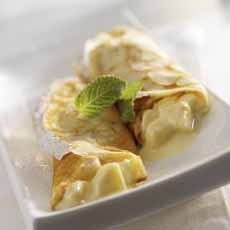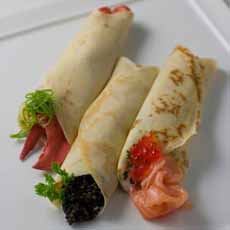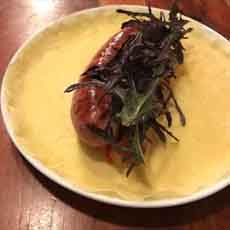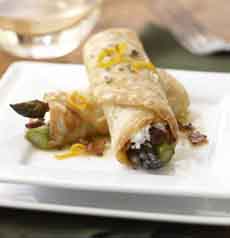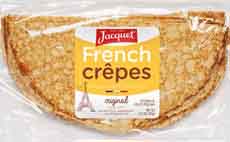A DIY Make-Your-Own Crêpes Party For Lunch, Dinner & Dessert
|
Today’s tip was inspired by this yummy photo from Wife Mama Foodie (photo #1). We thought: What a great idea for party food for a group of foodies: roll your own crepes. They can be savory crêpes for the main meal, along with a big green salad; or sweet crêpes for dessert. Just supply enough different fillings to make it interesting, and your DIY crêpes party will become a feast of legend. Here’s her recipe for easy homemade crêpes. You can also purchase ready-to-heat-and-eat versions (photo #6). Crepes are thin pancakes made from flour, eggs, milk, butter, and salt. The word was derived from the Latin crispus, curled. There are two principal types: > National Crepe Day is February 2. > National Bavarian Crêpes Day is March 22. Crêpes originated in Brittany, the region comprising the northwest of France. They were originally made with buckwheat flour and called galettes, meaning flat cakes. The term is still applied to savory crêpes, which remain buckwheat-based. Around the 12th century buckwheat, was introduced to Brittany. Common buckwheat was domesticated in Southeast Asia, at least by 4000 B.C.E. [source]. The plant, Fagopyrum esculentum is a member of the Polygonaceae family, which also includes edibles such as rhubarb and sorrel. Buckwheat—which is not a cereal and thus is gluten-free—has been grown in Tibet and northern China for millennia used to make noodles. It is a boon since wheat can not be grown in mountainous regions. It is the world’s highest-elevation domesticated plant. Buckwheat spread to Central Asia, Tibet, and the Middle East, and Europe. It thrived in the Breton moors, where it was called sarrasin or blé noir (black wheat—from the dark specks that often show themselves in the milled flour). It is high in fiber, has easily digestive protein, and contains all eight essential amino acids. Crêpes were initially cooked on large cast-iron hot plates, heated over a wood fire in a fireplace. Today they are made on the stovetop in special crêpe pans. The batter is spread with a tool known as a rozel and flipped with a spatula. In Brittany crêpes were (and are) served with the local beverage, hard cider. White flour crêpes appeared only at the turn of the 20th century. White wheat flour, which had been very costly—as expensive as sugar, honey, or meat—became affordable. In Brittany, both crêpes and galettes are traditionally served with cider. February 2 in France is a crêpe holiday, variously known as Fête de la Chandeleur, Fête de la Lumière, or Jour des crêpes. The feast has a tradition: Hold a coin in your dominant hand and a crêpe pan in the other, and flip the crêpe into the air. If you manage to catch the crêpe in the pan, your family will be prosperous for the rest of the year [source]. O.K., sure, but can we have some more crêpes, please? Pick your fillings of choice. Does it need a filling sauce, e.g. mustard sauce for the sausage? Does it need a garnish—for example, whipped cream or raspberry sauce for a banana crêpe? You can serve one crêpe as a first course or two as a main. Most work great with a béchamel (white sauce) or Mornay sauce (cheese sauce, a béchamel with gruyère). |
 [1] DIY crêpes: ready to fill, roll and eat (photo © Wife Mama Foodie | Facebook).
|
|
|
CHECK OUT WHAT’S HAPPENING ON OUR HOME PAGE, THENIBBLE.COM.
|
||
